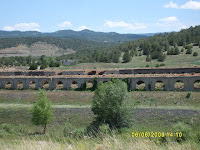
We went to Trinidad but I didn't get to update the blog with that information, so this will suffice. Trinidad was great fun. If you go- first stop at the visitors Center- get any info you might need for all of Colorado- but then take the FREE 1 hour city tour on the trolley. The man who drove us around (and there were only 5 of us) was full of interesting tidbits about the city. Apparently Trinidad was the stopping off point for many different ethnic groups moving west during the days of wagon trains. It makes perfect sense- many people probably had to stop, get jobs for short periods of time to fund the cost of food, etc. so they could complete their journeys westward. Retirement and RVs were not in anyone’s vision in those days. We are very fortunate to be able to visit the historical works of our ancestors- everyone should take whatever opportunity afforded and get out there and see this country. Anyway- the Italians and the Germans were some of the people who provided the excellent architecture, stone work and interior woodwork for this city. All of the brick used in Trinidad was made there- until the mid-1950s and most of the stone used in the buildings was mined in the vicinity. Apparently the Italians are responsible for the excellent stonework in the buildings. The workmanship is so good that none of the buildings have needed restoration and the city's plicy is to never touch any of the historical architecture unless it is falling down and there is a safety issue.


The tallest city building completed was the First National Bank- made of stone and even better, a year after it was completed the Italians returned and carved the existing stone into fanciful shapes, gargoyles, etc. There is speculation that this may be the only building in the country made of stone that has the actual stone carved into shapes rather than having them added after completion.

One of the really unique items to see is a graphic portrayal of Raton's history depicted in a ceramic mural. It was designed and completed by Sister Augusta Zimmer, SC and hangs in the Mount San Rafael Hospital entrance. It weighs about 3000 pounds, hangs on a reinforced interior wall and is 38ft W x 12ft H. According to the tour guide, there are 5000 pieces in the mosaic and Sister Zimmer was 80 years old when she finally completed the mural She did all of the work and spent 16 hour days on the scaffolding putting it up . I don;t know if all of what he said is true, but it is still quite a piece of art and my pictures do not do it justice. In any case, if you are interested, there are more pictures and explanations of what the different images portray in the web album.

After touring Trinidad and a fast lunch, we drove out the highway of Legends a few miles to another another interesting place - Cokedale, Co. It is a significant intact example of a coal miner's camp. The first thing you see as you come to Cokedale are black hills - they turned out to be slag heaps. There were 2 mines in Cokedale and one 9 miles north in Bon Carbo in the early 1900s. The mined coal was washed to remove impurities (mainly sulfur and phosphorus) in the Washer and then cooked in ovens to remove the moisture and the final product, coking coal, shipped off in rail cars. Coking coal was a necessary ingredient in the smelting and refining of iron since it burns with intense heat. The slag heaps we first encountered were where the remaining impurities were deposited.


The first picture is what is left of the coal washery and the next are of some of the 350 coke ovens that were at Cokedale, These ovens ran non-stop during the heyday of this town supporting the 3 mines in the vicinity.
There is quite a bit if history in Trinidad and the surrounding area. Come and see it for yourself!!
No comments:
Post a Comment